Related Research Articles
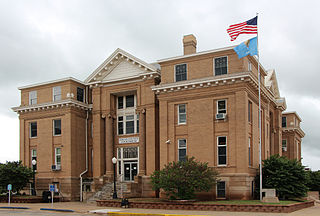
Logan County is a county located in the U.S. state of Oklahoma. As of the 2010 census, the population was 41,848. Its county seat is Guthrie.
Langston is a town in Logan County, Oklahoma, United States, and is part of the Oklahoma City Metropolitan Statistical Area. The population was 1,724 at the 2010 census, an increase of 3.2 percent from the figure of 1,670 in 2000. Langston is home to Langston University, the only historically black college in Oklahoma.

Boley is a town in Okfuskee County, Oklahoma, United States. The population was 1,184 at the 2010 census, a gain of 5.2 percent from the figure of 1,126 recorded in 2000. Boley was incorporated in 1905 as a predominantly Black pioneer town with persons having Native American ancestry among its citizens. Boley is currently home to barbeque equipment maker, Smokaroma, Inc, and the John Lilley Correctional Center.
Lima is a town in Seminole County, Oklahoma, United States. The population was 53 at the 2010 census, a 28.4 percent decline from the figure of 74 recorded in 2000.
Redbird is a town in Wagoner County, Oklahoma, United States. The population was 137 at the 2010 census, a 10.5 percent decline from the figure of 153 in 2000. Founded at the turn of the 20th century, it was one of more than fifty all-black towns in Oklahoma Territory and Indian Territory and is one of thirteen surviving black communities in Oklahoma.
Tullahassee is a town in Wagoner County, Oklahoma, United States. The population was 106 in both the 2010 and the 2000 censuses. It was the location of Tullahassee Mission, an Indian boarding school that burned in 1880. Because their population in the community had declined, the Muscogee Creek gave the school to Creek Freedmen, paying to replace the main building, and relocated with their families to the area of Wealaka Mission.

Langston University (LU) is a public land-grant historically black university in Langston, Oklahoma. It is the only historically black college in the state. Though located in a rural setting 10 miles (16 km) east of Guthrie, Langston also serves an urban mission, with University Centers in both Tulsa and Oklahoma City, and a nursing program in Ardmore. The university is a member-school of the Thurgood Marshall College Fund.
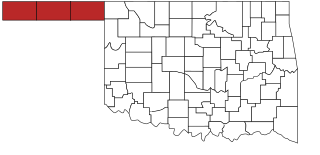
The Oklahoma Panhandle is a salient in the extreme northwestern region of the U.S. state of Oklahoma, consisting of Cimarron County, Texas County and Beaver County, from west to east. As with other salients in the United States, its name comes from the similarity of its shape to the handle of a pan.

John Mercer Langston was an American abolitionist, attorney, educator, activist, diplomat, and politician. He was the founding dean of the law school at Howard University and helped create the department. He was the first president of what is now Virginia State University, a historically black college. He was elected a U.S. Representative from Virginia and wrote From the Virginia Plantation to the National Capitol; Or, the First and Only Negro Representative in Congress From the Old Dominion.
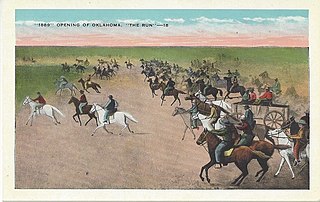
The Oklahoma Land Rush of 1889 was the first land run into the Unassigned Lands of former Indian Territory, which had earlier been assigned to the Creek and Seminole peoples. The area that was opened to settlement included all or part of Canadian, Cleveland, Kingfisher, Logan, Oklahoma, and Payne counties of the present-day US state of Oklahoma.

The Black Seminoles, or Afro-Seminoles are Native American-Africans associated with the Seminole people in Florida and Oklahoma. They are mostly blood descendants of the Seminole people, free Africans, and escaped slaves, who allied with Seminole groups in Spanish Florida. Many have Seminole lineage, but due to the stigma of having very dark or brown skin and kinky hair, they all have been categorized as slaves or freedmen.

The history of Oklahoma refers to the history of the state of Oklahoma and the land that the state now occupies. Areas of Oklahoma east of its panhandle were acquired in the Louisiana Purchase of 1803, while the Panhandle was not acquired until the U.S. land acquisitions following the Mexican–American War (1846–1848).

Edward P. McCabe, also known as Edwin P. McCabe, was a settler, attorney and land agent who became one of the first African Americans to hold a major political office in the American Old West. A Republican office-holder in Kansas, McCabe became a leading figure in an effort to stimulate a black migration into what was then the territory of Oklahoma, with the hopes of creating a majority-black state that would be free of the white domination that was prevalent throughout the Southern United States. In pursuit of this goal, McCabe founded the city of Langston, Oklahoma.
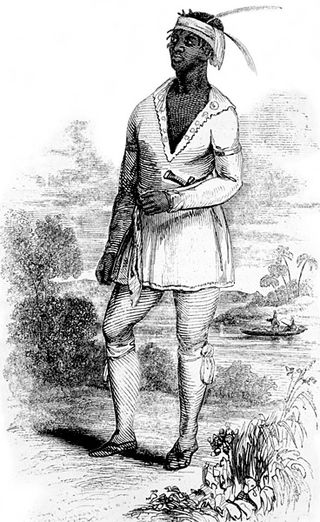
John Horse, also known as Juan Caballo, Juan Cavallo, John Cowaya and Gopher John, was a man of mixed African and Seminole ancestry who fought alongside the Seminoles in the Second Seminole War in Florida. He rose to prominence in the third year of what was to become a seven-year war when the first generation of Black Seminole leaders was largely decimated and the primary Seminole war chief, Osceola, fell into the hands of the American military commander, General Thomas Sydney Jesup.
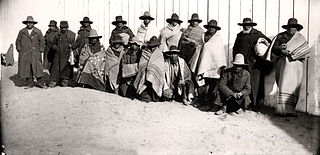
The Crazy Snake Rebellion, also known as the Smoked Meat Rebellion or Crazy Snake's War, was an incident in 1909 that at times was viewed as a war between the Creek people and American settlers. It should not be confused with an earlier, bloodless, conflict in 1901 involving many of the same people. The conflict consisted of only two minor skirmishes, and the first was actually a struggle between a group of marginalized African Americans and a posse formed to punish the alleged robbery of a piece of smoked meat.
Opaline Deveraux Wadkins (1912–2000) organized the first school to train black nurses in Oklahoma City, fought for desegregation of the College of Nursing at the University of Oklahoma and founded the School of Nursing at Langston University. She was the first African American nurse to earn a master's degree from the University of Oklahoma. She was honored in 1987 by the Oklahoma Public Health Association and inducted into the Oklahoma Women's Hall of Fame in 1993.
African-American self-determination refers to efforts to secure self-determination for African-Americans and related peoples in North America. It often intersects with the historic Back-to-Africa movement and general Black separatism, but also manifests in present and historic demands for self-determination on North American soil, ranging from autonomy to independence. The freedom to make whatever choices as a free American, and willfulness to do for self are often a key demand for advocates of African-American self-determination.

African Americans in Oklahoma or Black Oklahomans are residents of the state of Oklahoma who are of African American ancestry. African Americans have a rich history in Oklahoma. An estimated 7.8% of Oklahomans are Black.
References
Citations
- 1 2 3 4 Littlefield & Underhill 1973, p. 345.
- 1 2 Littlefield & Underhill 1973, p. 342.
- ↑ Littlefield & Underhill 1973, p. 343.
- 1 2 3 Cronin 2000, p. 74.
- 1 2 Littlefield & Underhill 1973, p. 347.
- ↑ Littlefield & Underhill 1973, p. 351.
- 1 2 Littlefield & Underhill 1973, p. 353.
- ↑ Cronin 2000, p. 76.
- ↑ Doolittle 2018, p. 408.
- ↑ Cronin 2002, p. 52.
- ↑ Waldron 2000, p. 65.
- ↑ Littlefield & Underhill 1973, p. 352.
- ↑ Cronin 2000, p. 72.
- ↑ Jessee 2006, p. 93.
Bibliography
- Cronin, Mary M. (2000). "A chance to build for our selves: Black press boosterism in Oklahoma, 1891–1915". Journalism History . 26 (2): 71–80. doi:10.1080/00947679.2000.12062544.
- Cronin, Mary M. (2002). "Mixing protest and accommodation: The response of Oklahoma's black town newspaper editors to race relations, 1891–1918". American Journalism . 19 (2): 45–64. doi:10.1080/08821127.2002.10677875.
- Doolittle, Sara (August 2018). "Contingencies of place and time: The significance of Wilson v. Marion and Oklahoma Territory in the history of school segregation". History of Education Quarterly . 58 (3): 392–419. doi: 10.1017/heq.2018.16 .
- Jessee, Sharon (2006). "The contrapuntal historiography of Toni Morrison's Paradise: Unpacking the legacies of the Kansas and Oklahoma all-black towns". American Studies . 47 (1): 81–112.
- Littlefield, Daniel F.; Underhill, Lonnie E. (1973). "Black dreams and 'free' homes: The Oklahoma Territory, 1891–1894". Phylon . 34 (4): 342–357.
- Waldron, Carolina A. (Fall 2000). "'Lynch-law must go!': Race, citizenship, and the Other in an American coal mining town". Journal of American Ethnic History . 20 (1): 50–77.